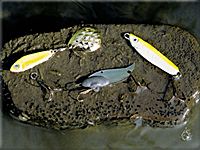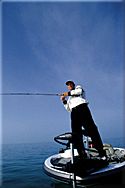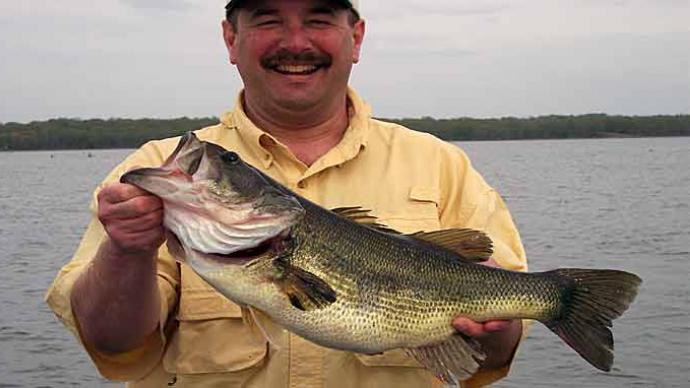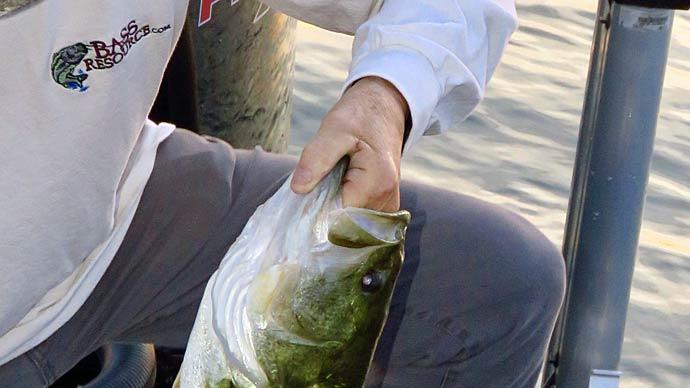
"What's with that thing?" was the remark from Kevin VanDam's partner at a recent tournament on Lake St. Clair. "Do you expect to catch a bass using that lure in this situation?" The "thing" was a compact metal lure, and VanDam was about to show him a thing or two.
Jigging spoons, blade baits, and tailspinners are three renegade lures often considered outcasts by fishermen brought up on a strict diet of jigs and worms.
These baits do not have the charisma or tournament-winning reputation of topwater, crankbaits, spinnerbaits, and soft plastic. As a result, novice bass anglers struggle to understand the basics of how, when, and where to fish this category of lures. Even among savvy professional anglers, not everyone fully comprehends the role of hard metal baits. But hard-metal rap is sure to become a big hit for those who do.
"I use all three of these lures," says VanDam, the FLW Tour's Angler of the Year. "The Crippled Herring is my favorite jigging spoon, the Silver Buddy my favorite blade bait, and the Fishlab Bio Shad Tailspinner is fast becoming one of the more versatile lures in my arsenal.
"Typically, none of them is my primary bait," VanDam continues. "I can't say I've won a tournament solely with one of these baits. But I have used them in events where I've done well, where one of these baits caught key fish. Many times I will weigh 20 bass, five of which will come on one of these three lures. So they help you out when it's needed."
With this category of baits, most bass anglers have some sense of their traditional use - basically as deepwater, vertical presentation lures. But for VanDam, the non-traditional ways of fishing these lures work best.

Jigging Spoon
"A jigging spoon is a great vertical bait, fished in the deep water of southern reservoirs during the winter," VanDam notes. "Over the years, I've caught a lot of bass doing just that, including a 4-pound largemouth taken in 65 feet of water at Lake Lanier on a Hopkin's Spoon - the deepest I've ever taken a largemouth.
"But that's not the way I fish a spoon most of the time. In clear-water northern lakes, bass are not that deep, and you can't get on top of the fish to jig vertically. So I work the spoon by casting it."
During cold-water periods of the early spring and late fall, VanDam will position his boat on a drop-off or at the deep edge of a flat. Then, he casts his spoon toward the outside edge of weed growth, where the vegetation begins to thin. He will fish depths from as shallow as 7 feet and as deep as 22 feet, working the spoon back to the boat with a lift-drop retrieve.
"Let it sink to the bottom with tension on the line as you follow it down. Once it hits bottom, lift the rod tip with a short, quick snap and turn the reel handle simultaneously to pick up the slack line. Do this to the boat," he says. "What I am trying to accomplish is short hops on the bottom. The spoon flips up maybe 8 to 10 inches then settles back to the bottom."
The ½-ounce Crippled Herring is his preferred model for this technique. He chooses his line diameter to control the rate of the spoon's fall - switching to a heavier line to slow the fall if he believes that is needed.
According to VanDam, this technique is particularly effective in the late fall, just before ice-up. Bass are in their winter locations at the base of drop-offs and the edges of big flats. "This is a great way to cover a lot of water to find fish quickly. The strike zone of bass at this time is so small that if you choose to fish a tube or grub, it will take you all day to find the bass."
Blade Bait

"I learned how to fish a Silver Buddy long ago from tournament fishermen up north," VanDam says. "The ½-ounce size is the only one I use."
He stresses the blade bait is an exceptional lure early in the spring, right after ice-out when the water is frigid. His technique is about the same as with the Crippled Herring Spoon, utilizing short hops while fishing the same type of locations as in the fall.
"This technique works great on both largemouth and smallmouth," VanDam continues. "We catch numbers of largemouth in the spring on this lure, sometimes 25 to 30 in a spot no bigger than a boat.
"The spoon does not produce nearly as well as the blade in the spring, but I do not know why. There must be something about the blade's vibration over the spoon's flutter when the water is so frigid."
VanDam fishes the blade bait on southern reservoirs in deeper water than he does up north. "In early spring at lakes like Table Rock or Bull Shoals, the fish often hold on chunk-rock banks. The key section to fish is where the river channel swings away from the bluff onto gravel flats. I use a blade bait to stair-step down the bluff tailing. This is the location for a big smallmouth, and the Silver Buddy is the lure to trigger the strike."

Tailspinner
Tailspinners have been widely used to target schooling bass-busting bait on the surface. Because the lure can be cast a "country mile," it has a particular advantage in reaching out to those soon-to-disappear schools of fish.
Since FishLab introduced the Bio Shad, VanDam has been experimenting extensively. He fishes this tailspinner more frequently than other lures in this category and constantly finds new applications. Due to unique design features, the Bio Shad can be used successfully in a wider variety of presentations than a typical tailspinner, according to VanDam.
The problems with many tailspinners are line twist and bass coming unbuttoned from the bait. Some features on the Bio Shad alleviate these concerns. For example, the blade is attached with a ball-bearing swivel rather than a clevis. This allows a more vertical fall and a free spinning blade with less line twist.
"I do so many things with the Bio Shad Tail that it has become a year-round lure for me," VanDam says. "I always seem to have one tied on a rod."
Among his favorite techniques with a tailspinner is when he is on an offshore crankbait pattern. "For example, I pull up on a deepwater ledge or point, catch a couple of bass on a crankbait real quick, then nothing. A tailspinner becomes my follow-up bait to check for suspended fish or inactive bass around the point or ledge. With the tailspinner, I can fish it from the surface to the bottom on a single cast. And when it hits bottom, I rip hard and let it flutter back down. I'm imitating dying or wounded shad - a deadly technique."
Another of his offbeat tailspinner techniques involves fishing on a flat where the average angler would throw a spinnerbait or lipless crankbait.
"Say there's a flat with scattered grass or perhaps a more solid weed bed growing several feet below the surface which is not uncommon on natural lakes. Or it could be a large sand bar flat like on St. Clair or a chunk-rock bank in a highland reservoir. Rather than a spinnerbait, I'll throw the Bio Shad and retrieve it over the top of the grass or cover to imitate a small baitfish. It provides a small, natural-looking profile, while the vibration and flash draw strikes."
Controlling Depth
Mike Iaconelli offers no hesitation when asked to choose his favorite season to chase smallmouths.
To effectively fish a tailspinner on a flat, particularly one with vegetation below, depth control is essential. VanDam chooses different line sizes to allow the bait to run deeper or shallower as needed in a particular situation. He chooses 14- to 20-pound test line to keep the bait above the weeds and drops down to 10-pound line to take the tailspinner deeper.
Another presentation for a Bio Shad is standing timber. VanDam relates a story about filming a television show during which the host started using another brand of tailspinner to jig in the trees. When VanDam switched to the Bio Shad Tail, both anglers noted the Fishlab bait fell more vertically. Also, the nose design kicked the lure away when it contacted a tree trunk or limbs.

"I also love to throw the Bio Shad around bridge pilings any time of the year," VanDam continues. "It's possible to cast it out and swim the tailspinner along the top of the water column. Then on successive casts, count it down the water column and retrieve it at different depths. Continue going deeper until you end up jigging it straight down. You don't know where the bass might be located on a piling - 5, 10, 20 feet, or deeper. In the summer, they are usually in the top 10 feet, but in cold-water periods they may be in 30 feet. With a tailspinner, it's possible to cover all the depths effectively by slowly working the bait down a level at a time."
VanDam employs the same rod-and-reel combo for all three lures. His selection is a 7-foot 1-inch medium-action casting rod with a high-speed retrieve reel. The fast reel enables him to quickly pick up slack line when hopping baits on the bottom and make speedy retrieves when casting one of these heavy weights to schooling fish.
So what happened during that St. Clair tournament when a partner questioned using a tailspinner as a spinnerbait over the flat? Well, VanDam caught keeper smallmouth on it, several of which ended up in his bag for weigh-in. So while VanDam didn't score the win, he did finish a respectable sixth under some challenging conditions.
His advice? "Don't be caught without hard metal in your tackle box."
Traditional Spoonin' is Sweet Music for Anglers
Jigging spoons are typically used for fishing deep structure, such as a river or creek channel, particularly during a cold-water period.
"During winter, deepwater bass in southern reservoirs are relating to shad," explains VanDam. "Find the bait, and then you'll find the bass. So I'll cruise back and forth in creek arms until I locate the balls of baitfish.
"This kind of fishing is all about electronics. I do not even drop a spoon until I see the right stuff on the sonar. I look for a lot of bait in conjunction with a depth change-sometimes you will see large marks that may be bass, sometimes you don't. First, find the activity zone of the bait and then follow that depth until contact with the structure is made. The key zone is often 35 to 45 feet deep."
When VanDam drops a jigging spoon down to deepwater bass, he pays attention to his line to detect a strike. "I've had the best success by snapping the spoon and following it down on a semi-tight line. You want the spoon to flutter down, not be lowered back on a too-tight line. Bites are subtle, rarely knocking slack in the line - white bass and stripers do, but not black bass. Set the hook if the spoon does not fall back after a snap, or you feel a slight tick or see the line jump."
Hook-up Insurance
The basic design and weight of these hard, metal lures often permit bass to throw the bait with a shake of the head. In addition, as already noted, fish loss is reduced by the design of the Bio Shad tailspinner. VanDam, however, takes an additional step to lessen the chance of losing bass.
"By replacing the stock hook with a No. 4 Mustad Triple Grip, I've been able to keep more bass hooked on a Bio Shad than any other tailspinner type bait. Bass do not throw a Triple Grip nearly as easily as standard trebles," VanDam says.
"Likewise, I also change the stock on all my spoons to a Triple Grip. I would very much like to switch Silver Buddy hooks for Triple Grips, but using a split ring to attach a hook on a blade bait throws the lure out of balance. And it's that fine balance that puts out the great vibes."
Content provided by Bass Fishing Magazine, the official publication of FLW Outdoors
BassResource may receive a portion of revenues if you make a purchase using a link above.




